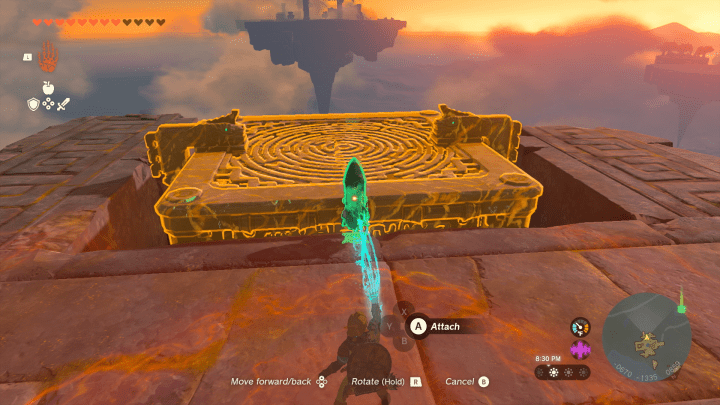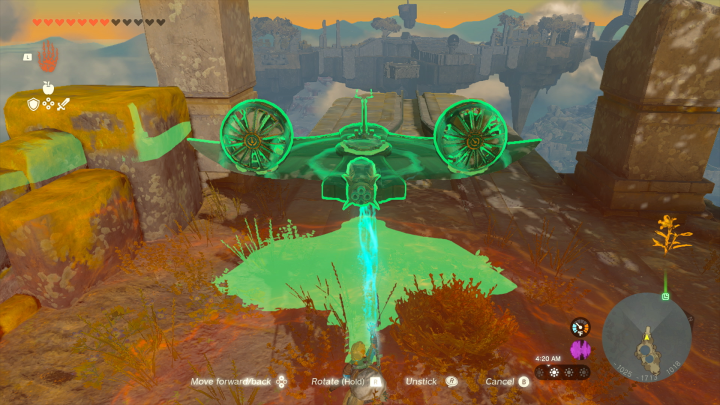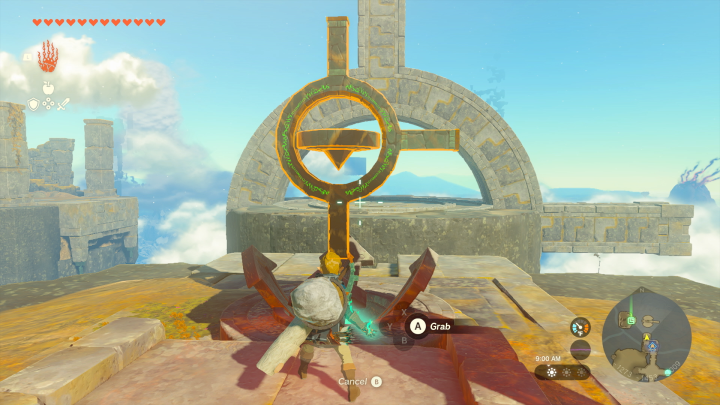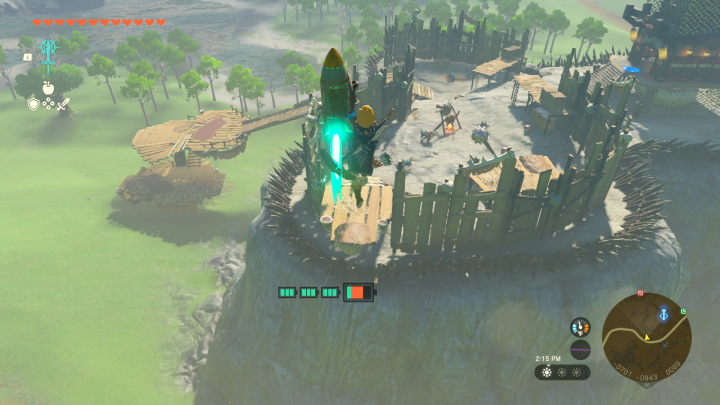Ever since Nintendo lifted the lid on The Legend of Zelda: Tears of the Kingdom with a 10-minute gameplay demo, my mind has been abuzz. I couldn’t stop thinking about its new crafting system, which lets Link create some weapons Frankenstein-style and piece together makeshift vehicles using his new Ultrahand ability. Every time I thought about it, I found myself asking one question: What else is possible?
I’d get to discover that answer firsthand during a hands-on, 70-minute demo of Tears of the Kingdom. While I’d barely get to see much of the game (with my play session largely confined to a select set of sky islands), it would be all the time I’d need to push the crafting systems to their limits and discover just how creative — and moronic — I could get in an hour. Even with a good month to dream about what I’d do when I first laid hands on the game, I couldn’t even begin to imagine the absurd hijinks that were in store for me.
Based on the small slice I played, The Legend of Zelda: Tears of the Kingdom feels like a cross between an educational engineering tool and an improv comedy show. Despite some fairly complicated controls, it didn’t take long before I was completing quests in increasingly impractical ways that had me on the floor laughing at my mad scientist hubris. That makes for a sequel that feels entirely different from Breath of the Wild: a freeform traversal puzzle game where experimentation is rewarded in spectacular fashion.
The cable car solution
The first 20 minutes of my demo are a bit of a guided control tutorial with a Nintendo rep walking me through each new tool, from Ultrahand to Ascend. It’s a lot to take in at once. If you thought Breath of the Wild’s controls were complicated, Tears of the Kingdom only compounds that by adding a crafting layer on top of its myriad of submenus. Say I want to attach a Keese wing to an arrow, allowing it to fly farther. I need to aim my bow, press up on the D-pad while it’s drawn, scroll over to the item, and release to equip it. I’ll need to do that for each individual arrow, as there wasn’t a way to craft arrows in bulk during my demo.
I wouldn’t fully get the hang of it all by the end, as I was still mixing up how to access which menus. Even trickier is rotating objects grabbed by Ultrahand. To do so, I’d have to hold the right bumper and use the D-pad to spin whatever I was holding. Objects don’t snap to hard angles, so it could be hard to line them up exactly how I wanted them with only four directions. Granted, I was thrown straight into the game without a proper tutorial, so I imagine the full release will more smoothly introduce players to each system. Even so, I imagine that might be one common sticking point players wind up having with it.

While the controls might not be totally intuitive, crafting itself absolutely is. Within seconds, I was already causing chaos as I glued a bunch of wooden planks onto a Korok’s backpack (the creatures return here, as do collectible Korok seeds). From there, I’d immediately get to solve some traversal puzzles using my imagination. First, I’d need to get to another island connected by metal tracks. After goofing around and trying to build a fragile wooden monstrosity, I’d grab a minecart, place it on the tracks, attach a fan to it, and ride it across.
A good deal of the vehicles I created revolved around new items called Zonai Devices. These are largely electric components that can be attached to just about anything. During my demo, I’d use fans to propel static objects, place rockets on platforms to launch them into the air, and use a fire igniter to activate a hot air balloon. Other Zonai Devices I saw included a one-time-use mobile cooking station and a steering column to let Link turn vehicles. The twist here is that all of these use electricity, which is a new stamina-like resource represented by batteries. All Zonai devices activate at once when Link smacks his invention and they’ll stop running when all batteries deplete. Battery power automatically regenerates over time, and a Nintendo rep implied that there’s a way to upgrade how many batteries Link has in total.

With the fundamentals of vehicle-building down, I’d get a little more creative when I bumped up against another set of tracks. This time, I found a large metal hook lying in the grass and hung it off one of the rails. I’d attach a minecart to the bottom of that this time, essentially turning it into a cable car that I could sit in as a fan blew it up the track. At that moment, I felt like an engineering genius; I successfully made a hypothesis (“I bet I can create a cable car”), set up an experiment, and proved my theory. Tears of the Kingdom ingeniously turns the scientific method into a core gameplay hook, creating an experience that almost feels more like old-school bridge construction simulators than Zelda.
After 20 minutes, I was already drunk with power. I refused to leave my demo without creating an unforgettably chaotic moment.
Chaos theory
The best way I can illustrate how Tears of the Kingdom plays isn’t by breaking down individual systems, but by retelling a few anecdotes. The bulk of my playtime would revolve around a relatively simple questline. Starting on the ground in Hyrule, I’d need to break into a moblin base surrounded by spikes, get to the sky from there, make my way across a series of floating islands, grab a stone, and backtrack with it to a previous island to set it in place. As it turned out, there were a lot of different ways I could handle that. And that’s an understatement.
I’d start by doing it the old-fashioned way: storming the front gates. I’d be met by a trap that felt like it was pulled out of FromSoftware’s sinister playbook, as a giant metal ball came hurtling down the ramp toward me. I’d sidestep it and immediately discover an opportunity. Using my craft tool, I’d attach that ball to a stick to create an enormous morning star. Then, I’d graft an exploding red barrel onto my shield. I raised my shield as two bokoblin swung at me, blowing them up. I’d run into the base from there and launch into the sky.

Later in the demo, I’d ask the Nintendo rep to scrub back to a save before I entered the base. I wanted to see if I could get in using stealth. I walked around the perimeter until I found some wooden planks lying around. I quickly pieced together a rudimentary airship, complete with masts poking out from each side like oars. The plan was to fly over the fence and jump in behind the bokoblin entirely, letting me launch to the sky without initiating a battle. I’d stick a hot air balloon and a steering column to the front to let it fly. Then I got a bright idea: What if I strapped two rockets onto the back to lift me into the sky even faster?
Hubris ensued.
Upon grabbing the steering column, all the Zonai Devices activated and, sure enough, sent my wooden vessel flying straight up. There was just one thing I hadn’t accounted for: that I was flying a very flammable ship. The fire from the rockets quickly set the entire ship on fire, forcing me to abandon ship and glide over to a tower in the base. With no one at the helm, my ship fell out of the sky … and directly into the base. It smashed into some red barrels, creating an enormous explosion that took out the bokoblin anxiously standing by the front gates waiting to ambush me with their metal ball trap. Mission accomplished, I guess?
Before my demo, a Nintendo rep joked that he saw Tears of the Kingdom as “Yes, And: The Game,” referring to the improv comedy rule of thumb that dictates how an improviser should escalate a joke. That’s exactly what I experienced at that moment. Yes, you can make an airship. And it’s going to immediately catch fire. And it’s going to crash into some monsters. It was a hysterical moment that has me confident that Tears of the Kingdom will be the funniest game of the year, bar none.
The flying stone
Once I got up to the sky islands, I’d have to put everything I learned to the test. I began confidently creating new ways to hop from island to island. To cross one gap, I’d strap a rocket onto my shield and hold it to send me flying into the sky, letting me glide toward the next island and dive down onto it. For another, I’d fly a different electric machine to the edge of an island and leap off it at the last second to grab hold of the rocks and climb up. It was like a Mission: Impossible stunt — and one that allowed me to accidentally skip half of the island in the process.
And yet, my greatest accomplishment was still to come.
Upon getting back on solid ground, I’d come across what should have been a very simple puzzle. I’d need to cross one small round island, get to a final island, grab a stone, and walk it all the way back. To do so, I’d have to use Ultrahand to grab a floating ball that would rotate the middle island. I quickly noticed there was a bridge jutting out from one side, so the first part of the solution seemed simple enough: create a bridge between the first two islands to cross.

What I didn’t realize, though, is that there were actually multiple bridges attached to the middle island. Had I seen that, I could have rotated it in a way that would have connected all three islands and allowed me to simply walk the stone to where it needed to go. Instead, I strapped a rocket onto my shield and flew to the third island, leaving me with no path to walk across. Had I soft-locked myself? Absolutely not. I’d just have to create my wildest invention yet.
I attached a hot air balloon to the top of the stone, creating a way to take it airborne. To move it forward during its ascent, I’d stick a fan to the back. Worried it might sink too low during the flight, I attached two more fans to either side of the first one pointing downward. That would theoretically give it enough power to float as it moved forward, counteracting some of the stone’s weight. There was one last problem to solve: How would I get across with it? After some thinking, I chopped down a tree and attached it to the row of fans, creating a platform I could stand on.
At this point, various Nintendo reps started gathering around, completely flabbergasted by what was happening. I had somehow turned the stone into a flying car, which was clearly not the way anyone expected the quest to be completed. Everyone braced for catastrophic failure as I whacked the device and activated all the Zonai devices … but I swear, it worked. The weight distribution was somehow perfect, letting the airship fly straight back to the first island. When I got above it, I deactivated everything with another smack and landed safely below. I attached the stone, set it down where it was supposed to go and completed the quest. I should have finished it in a minute or two by rotating a ball a few times. Instead, I turned it into a 20-minute test of ingenuity that’s among the greatest things I’ve ever accomplished in a game.

And don’t forget: This was just in the confines of a very, very limited demo. I’d barely even begun to experiment with Link’s rewind ability, only using it to send the metal fortress ball back into the gates (crushing some bokoblin in the process). I wouldn’t even get too deep into weapon crafting — though I would attach a fire igniter to a spear, causing it to shoot a fireball every time I poked forward.
Those 70 minutes I spent in Hyrule felt truly limitless. I can’t imagine that anyone else in the room had the same experience as me despite the fact that we all had the same inventory to work with. I’m sure I could have spent hours replaying that same short demo, testing out a dozen solutions just with what I had on hand. If Tears of the Kingdom can deliver that experience at the same scale as Breath of the Wild, we may be looking at a game with a decade’s worth of surprises in store.
The Legend of Zelda: Tears of the Kingdom launches on May 12.
Editors’ Recommendations
Credit: Source link


Comments are closed.